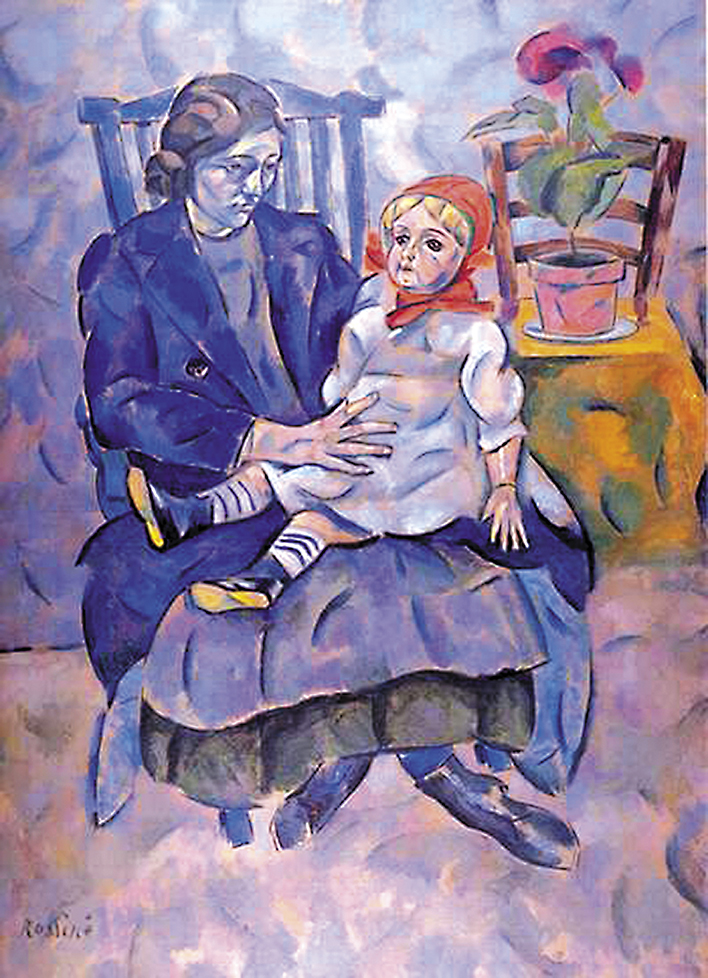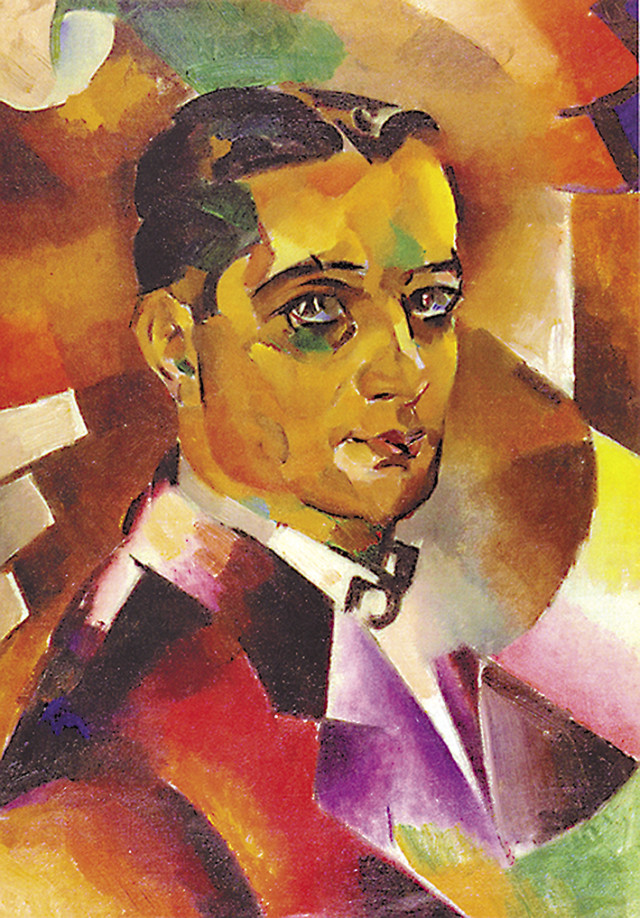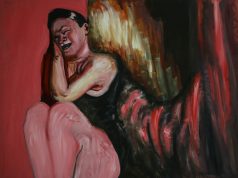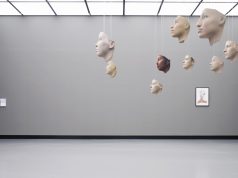The remarkable Odessa educated, French-Russian-Jewish artist Vladimir Baranov-Rossine was killed in the holocaust, but his work lives on. In recent decades he has become one of the most sought after artists on world art markets. Today, Baranov’s works can be seen in New York’s Museum of Modern Art, the Georges Pompidou Center in Paris, the Tretyakov Gallery and State Museum of Russia, the Ludwig Museum in Cologne and the Hirshhorne Museum in Washington, the Wilhelm Lehmbruck Museum in Duisburg and numerous personal collections. This article is part Yevgeniy Demenok’s column on the history of the Modernist movement in Odessa and Ukraine.
Without a doubt, early 20th century Paris was the world capital of the arts. Artists and sculptors from all over the planet came to Paris to take part in the avant-garde of the international art scene. New styles and directions materialized weekly. The paradox of the Paris School of the early 20th century was the fact that it grew and developed, in a very large part, due to the efforts of the artists who came to live and work in Paris from elsewhere — that is, immigrant artists. Figures such as Pablo Picasso and Amedeo Modigliani, Constantin Brancusi, Kees Van Dongen, Jules Pascin and many others gained renown and became leading figures of the art world after relocating to the French capital. A large role in the development of the French School was played by émigrés who arrived from all across the Russian Empire. This group included Marc Chagall, Aleksandr Archipenko, Khana Orlova, Aleksandra Ekster, Chaim Soutine, Mikhail Boychuk, Mikhail Larionov, Nataliya Goncharova, Aleksey Yavlensky, Osip Zadkine, Jacques Lipchitz, Ivan Puni and Sonia Delaunay.
Of course, where there are talented immigrants, one will always find Odessites among them. The list of Odessan names among the ranks of Parisian artists is impressive: Wassily Kandinsky and Theophilus Fraierman, Nathan Altman and Vladimir Izdebski, Josef Bronstein, Jacques Gotko, Manya Mavreau, Isaac Feder, Sandro Fazini, Sigizmund Olesevich, Moisey Sterling, Savely Schleifer, Mikhail Berg, Jakob Bilit, Maurice Biner, Osip Braz, Sergey Bulakovsky, Georgiy Vakevich, Aleksandr Golovin, Anita Gorshitz, Asya Granaturova, Naum Granovsky, Mikhail Drizo, Vladimir Zagorodnyuk, Mikhail Zadunaysky, Samuil Tzives, Max Silbert, Josef Konstantinovsky, Mikhail Latrie, Aleksandr Finkelshteyn, Mikhail Fotinskiy, Aleksandr Frenel, and even Princess Anna Gagarina-Sturdza. All of the artists mentioned above not only lived, worked, or studied in Paris; they exhibited their works in the most famous Parisian salons, especially in the Autumn Salon and the Salon of the Independents. The list itself is far from exhaustive.
There is another name in this list which truly stands on its own: that of Vladimir Baranov-Rossine.
Shulim-Wolf Baranov was born on January 1st, 1888 in the Bolshaya Lepetikha village of Melitopolsky region of the Tavricheskaya governorate (currently in the modern day Zaporozh oblast of Ukraine) to the family of a Melitopolsk merchant David Baranov and his wife Rosalia. In 1903, when he was fifteen, Baranov was accepted to the Odessa Academy of the Arts, from which he successfully graduated five years later.
During his time as a student at the Academy, Shulim Baranov’s first works were shown at several Odessa exhibitions hosted by the “South-Russian Artists’ Fellowship,” including the XII exhibition that was opened in October 1906 in the City Museum of the Fine Arts at the address of 5 Sofiyevskaya Street, where the Museum of the Arts is located today. In the exhibition’s catalogue he is named as “S. Wolfov.” His contribution consisted of four sketches, numbered 55 through 58. The fellowship’s XVII exhibition opened at the same location in October 1907, and in that catalogue the artist’s name was given as “V. Baranov.” His address is indicated to be the Academy of the Arts on Preobrazhenska Street. At the time, providing the academy as their address was a common practice for students who moved from one rental dwelling to another and did not have a consistent domicile. At the following exhibition Baranov’s address would be given as the Emperor’s Academy of the Arts in St. Petersburg.
Even Baranov’s earliest works already showed an impressive talent. For example, his excellent “Odessa Landscape” from 1905 was the first work listed in the catalog of the “Three Russian Avant-Guardists” exhibition (Malevich, Baranov-Rossine and Mansurov), shown from 1972 to 1973 in the Georges Pompidou Centre. His famous 1907 pointillist canvas, “Self-portrait with Brush,” looks like the masterpiece of a fully developed artist, but Baranov-Rossine was only 19 when he painted it. Self-portraits were somewhat of a specialty for the artist — he painted many of them in various styles. The cubist self-portraits from the first half of the 1910’s are among his most well-known works.
His works were soon noticed by the public and critics alike. M. S. Linsky wrote: “G. Wolfov contributed only several sketches to the exhibition, but even those are enough to confidently predict a bright future for the young artist. The sketches must be recognized as the best works on display at the exhibition.” Vladimir Baranov’s works are also mentioned in articles by N. Skrotsky, Tanagra, Mikhail Solomonov.
Throughout his artistic life, critics would often accuse Baranov-Rossine of unoriginality, ambiguity, and an inability to find his own style. Although he did circulate between numerous styles in his art —Neoimpressionism, Fauvism, Cubism, Orphism and abstractionism being just some of them — each canvas was imprinted with his individuality, an aspect that was uniquely his. In his book “The Paris School,” Mikhail German describes the artist in the following way: “…he had the good fortune to become a nuanced and precise interpreter of [the Paris School’s] main tenets. He did not simply copy the processes happening in the contemporary art world, but rather studied and “represented” them. …He was European and Russian in equal amounts, and felt comfortable within this duality. …He was not disoriented by variety — he embraced it. It is hard to say what the main trait of his personality was — perhaps the wisdom of an analyst and a historian of his own times.”
During his first trip to Europe, when he was still a student, Baranov-Rossine met the Dadaist artist Hans Arp, with whom he struck up a lasting friendship. His amicability and penchant for easy friendships aided him in entering the top echelons of the contemporary art world. For example, his friendship with David and Vladimir Burliuk helped propel him into the top ranks of the Russian avant-gardist society. It is most likely his fascination with the avant-garde world that led him to abandon his studies at the Emperor’s Academy of the Arts in St. Petersburg — he was expelled for truancy in December 21, 1909. More important things were on the young artist’s mind — and they included Paris.

After arriving in the city of lights in the autumn of 1910, Vladimir Baranov took on the nom de plume “Daniel Rossine,” which he would change in 1917 to the now-recognizable “Vladimir Baranov-Rossine.” In Paris, he found himself caught up in artistic life — he befriended Robert and Sonia Delaunay, lived in the “La Ruche” artists’ colony where he counted Marc Chagall among his neighbors and participated in the salons hosted by the Baroness D’Ettingen and Serge Ferrat. And of course, he continuously exhibited his works. Up until 1914, Baranov-Rossine exhibited his paintings and sculptures in the annual springtime Salon of the Independents as well the Autumn Salons.
This first Paris period was definitive and extremely productive for Baranov-Rossine. Having tried his hand at various painting styles — including Cubism and Orphism — he began to dedicate his attention to sculpture. While in his paintings Baranov-Rossine often followed or drew inspiration from existing styles, in sculpture he became a true innovator. He was one of the founders of “polytechnic sculpture,” also known as “assemblages.” These innovative sculptures were made from combinations of varied and unexpected materials — glass, plywood, plastic, metal, eggshells — with more traditional sculpture materials like wood and plaster. These naturally attracted attention and in 1913 he exhibited his “Rhythm” (made of wood, cardboard and eggshells) in Paris. The work is now owned by the New York Museum of Modern Art.
After the start of World War I, Baranov-Rossine fled first to Norway; and then, in 1917, to Russia. In the “new” Russia, the artist’s creativity received an influx of energy. Baranov’s friends from his academy days, Anatoly Lunacharsky and David Shterenberg, were now at the very top of the art pyramid. He began working at the Arts Department of the Soviet Ministry of Education and became a member of the Artists’ Assembly. In 1918 he began working as a teacher at the Petrograd Workshops of the former Academy of Arts. During that time, the Ministry of Education purchased several of Baranov-Rossine’s paintings to display in the Museum of Art and Culture. Six of those works are currently located in the Russian State Museum. From 1919 to 1921, he served in various professorial positions, ultimately becoming the dean of painting at the Russian State Art and Technical School.
However, life in the USSR turned out to be less harmonious than expected, and in 1925 the artist accepted Robert and Sonia Delaunay’s invitation to return to Paris with his oldest son Yevgeniy and wife Polina. He quickly adapted to the shifting cultural landscape and began catching up on time lost in Soviet Russia. He met with old friends, the Delaunay family and Hans Arp, who by that time had become one of the leading figures of the international Dadaism movement. During the late 1920’s and early 1930’s, Baranov-Rossine created numerous works in a new style for him — surrealism. Of course, as usual, he showcased these new works in various exhibitions. In 1933, his “Polytechnic Sculpture” attracted the attention of connoisseurs and critics, having a polarizing effect amongst the latter. In 1972, the work became part of the permanent collection in the National Museum of Modern Art in Paris.
Besides his clear artistic talent, Baranov-Rossine was also amply gifted with the spirit of invention. In 1930, he became an official member of the Intellectual Workers’ Association of Paris. In 1934, he invented and patented his “multiperco” device, which was used for the “fabrication, sterilization and dispensation of various gasified liquids.” This fabulous device received two grand prizes at the Technological Achievements Expo. In 1938, he invented the “photochronometer” — a device for the analysis and classification of precious gems. At the beginning of World War II, the artist was also conducting trials of his new invention — “chameleon” or “dynamic camouflage,” intended to be used for the masking of military equipment. However, a device called the “optophone” or the “optophonic piano” was destined to become Baranov-Rossine’s greatest and most lasting invention.
He first began work on this fabulous invention back in 1909. The optophone itself was most likely constructed in France, and the first optophonic concerts given in Christiania, Stockholm. In the early 1920’s, the artist created the “clavier” — a new variation on the optophone. After several years of revisions and improvements, the optophonic piano was complete. In October of 1923, Baranov-Rossine conducted a trial demonstration of the instrument in Moscow. Two more concerts were given at the Moscow Meyerhold Theater in 1924. The posters advertised the performance as “the first of its kind in the world.”
In 1925, Baranov-Rossine gave a series of optophonic concerts in Paris, Riga, and Berlin. He would continue to give these concerts in Paris for the following few years, including as a guest of the Paris Symphonic Orchestra. In 1927, he founded the first “Optophonic Academy” in Paris where he taught drawing, painting, and sculpture while using his “optophonic piano” system. He received the original patent for his “optophonic piano” in 1926 under the title of “mechanical device for the composition and combination of images and colors.” It is thanks to this patent that the first “optophone,” destroyed during World War II, was able to be reconstructed. Today the device is on display at the Georges Pompidou Center.
In the author’s own words: “Imagine that every key on a piano can fixate or move about at alternating speeds a specific element in an array of transparent filters, through which a ray of white light passes.”
When World War II began, Vladimir Baranov-Rossine decided to remain in Paris with his family. “I love Paris and I am not afraid of anything” — he is quoted as telling a family friend. According to his family, Baranov-Rossine’s last completed work was his “Still Life with Vase,” painted in December 1942 on the occasion of his son’s birthday.
On November 9, 1943 the artist was arrested by the Gestapo. He was deported to Germany on January 20, 1944 and died five days later in Auschwitz. Many of his peers, Odessan artists who had relocated to Paris (Adolphe Feder, Sandro Fazini, and Saveliy Shleifer) died at the same death camp in the surrounding years.
The 1970’s heralded Baranov-Rossine’s triumphant return to the world art scene. In 1970, London’s Rutland Gallery hosted a large-scale retrospective of his works. In 1971, the artist’s “optophonic piano” functional sculpture caused a sensation when it was displayed at the Leonard Hutton Gallery in New York. Starting in 1973, Baranov-Rossine’s works were exhibited frequently across Europe and the USA. His native country remembered his talent as well — works by Baranov-Rossine were displayed at the “Moscow-Paris” show in St. Petersburg in 1981, at the “Ukrainian Avant-Garde” exhibition in Munich in 1993, and in 2002 when the Tretyakov Gallery in Moscow hosted another grand-scale personal retrospective of sculptures and paintings by the artist. Today, Baranov-Rossine’s works are housed at the most prestigious museums all over the world, and routinely fetch record prices at art auctions. In the early 1990’s, sale prices were in the tens of thousands of dollars, and they have crossed the million dollar threshold since 2000. In 2004, Baranov-Rossine’s 1911 work “Still Life with Chair” sold for $1,184,000. In 2008, the 1910 canvas “Rhythm (Adam and Eve)” sold for 2.72 million pounds, at almost double the estimate.
Eugene Demenok is a writer, journalist, and cultural historian who has authored five books. He is a winner of the Paustovsky’s Municipal Literary Prize for his 2014 book “New, on the Burliuks.” He is a founding organizer of Odessa Intelligentsia Forum and a member of the Presidential Council of the Worldwide Club of Odessans.




































